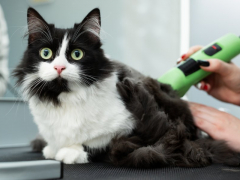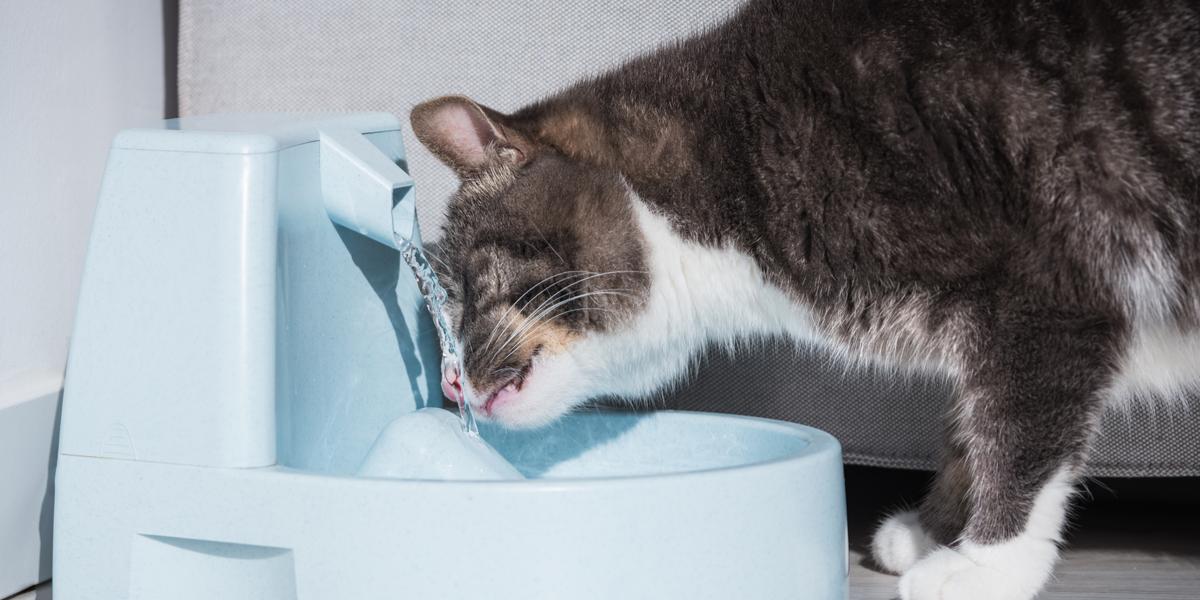
This article aims to explain all about dehydration in cats, including causes of dehydration in cats, signs of dehydration, and how to treat dehydration in cats.
What Is Dehydration in Cats?
Dehydration describes the condition of a cat when excessive fluid has been lost from a cat’s body, which has then not been replaced by sufficient water from drinking. As well as the loss of fluid, there is usually also the loss of essential minerals, such as sodium, potassium, and chloride.
Dehydration is a serious issue, often caused by underlying health problems, and it is a complication that can lead to even more serious consequences for the cat. For this reason, it is very important that dehydration is identified and corrected by rehydration, usually using fluid therapy, supervised by a veterinarian.
Why Is Dehydration So Significant?
Water is essential to your cat’s health. Cats need to continually replace the fluids that they lose through their urine and feces. Water is essential for your cat’s general circulation, digestion, and waste removal. If dehydration is left untreated in a cat, the condition can lead to other severe medical concerns.
Causes of Dehydration in Cats
Broadly, dehydration happens when a cat suffers excessive fluid/water loss and/or does not drink enough water.
The most common underlying causes of dehydration are:
- Chronic renal failure (chronic kidney disease)
- Gastrointestinal disorders such as vomiting or diarrhea
- Collapse due to many possible causes
- Hypovolemic shock due to many possible causes
- Heat stroke or overheating
- Surgery (during and after anaesthesia)
- Metabolic crises and medical conditions, such as hyperthyroidism, hypoglycemia, or diabetes mellitus
- Poisoning
How Common Is Dehydration?
Dehydration is a common complication of a number of serious illnesses, as listed above.
What Are the Signs of Dehydration?
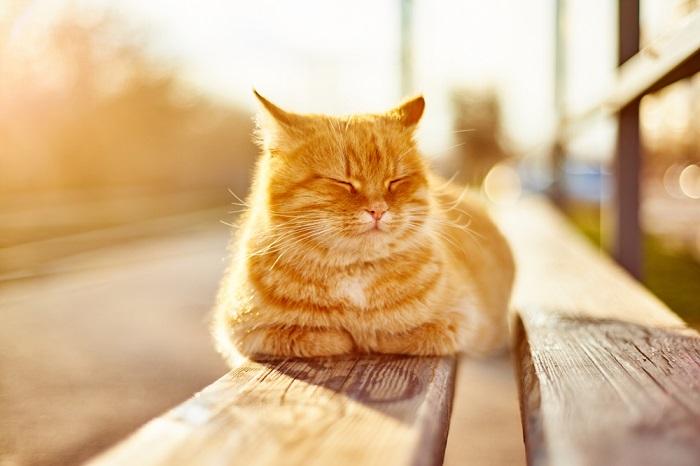
Dehydration can be caused by many things, including bouts of vomiting and diarrhea.
Symptoms of dehydration include the following:
- Dullness and weakness
- Collapse
- Lack of appetite
- Sunken eyes
- A cat’s gums will feel dry and tacky to touch
- The cat may visit the litter box less often, producing only small amounts of urine
The clearest way to determine if a cat is seriously dehydrated is by skin tenting. When the skin overlying the cat’s side or shoulders is gently pinched, it should normally flatten down again immediately due to natural skin elasticity.
If a cat is suffering from severe dehydration (more than 10% dehydrated), the skin is less elastic, and pinched skin remains in an elevated, tent-like shape. This is a basic test of dehydration, and if your cat’s skin “tents,” urgent rehydration by a veterinarian is needed.
What Needs To Be Done To Help a Cat Suffering From Dehydration
If you suspect that your cat may be dehydrated, you need urgent professional help from your veterinarian. Your veterinarian will go through a process of decision making and tests to determine how dehydrated the cat is. This will allow a decision to be made as to whether or not they need to be rehydrated using fluid therapy.
The following process is usually followed.
Detailed History Taking
When you visit the vet with your cat, the vet will discuss every aspect of your cat’s life and health care, obtaining a full background to your cat’s current problem. This will include questions that relate to your cat’s fluid balance, such as how much your cat is drinking, and any signs that could lead to fluid loss (such as vomiting or diarrhea), as well as the pattern of urine production.
Physical Examination
Your veterinarian will check your cat over carefully, noting any physical signs of illness, and paying particular attention to your cat’s hydration status. If a cat is severely dehydrated (more than 10%), the skin will “tent” when a fold of skin is gently pinched (i.e., the skin stays in a tent-like position rather than flattening down immediately as it should do in a normally hydrated cat).
The heart rate will be checked. This may be faster or slower in a dehydrated cat, depending on a range of other factors.
The mucous membranes (e.g., the gums) will be assessed; these are dry and tacky in a dehydrated cat, due to reduced perfusion with blood.
Your veterinarian will check capillary refill time by pressing gently on your cat’s gums. This gives information about the blood flow to the gums.
Your cat’s body weight will be recorded, as this is an important part of the calculations that need to be done when working out how much fluid needs to be given to a dehydrated cat.
All of these factors are repeatedly reviewed by a clinician when a cat is in veterinary hospital being given fluids as treatment for dehydration.
Routine Blood Tests
It’s likely that your veterinarian clinician may also carry out blood work, including hematology (blood count, measuring red blood cells and other aspects) and biochemistry profiles, to find out more about the inner metabolism of your cat.
This often includes a packed cell volume (PCV), which is a useful way of working out a cat’s state of hydration. It’s often used to calculate the volume of fluid needed to rehydrate a cat. This is reviewed with the total protein in the blood, and the albumin level, as a way of making the necessary calculations.
The blood sodium and potassium may be measured; in some cases, potassium supplementation is an important part of fluid therapy if a cat’s blood potassium levels are too low when they bare dehydrated. Other electrolytes may also be measured, and the acid-base balance may be assessed.
All of this information is useful when working out what treatment is needed for a dehydrated cat, including what type of fluid needs to be administered, at what rate, and how much.
Other Tests
Your veterinarian may measure your cat’s blood pressure. A dehydrated cat with low blood pressure (hypotension) needs a different amount of fluid than a cat with normal blood pressure.
What Type of Fluid Is Used To Treat a Cat Suffering From Dehydration?
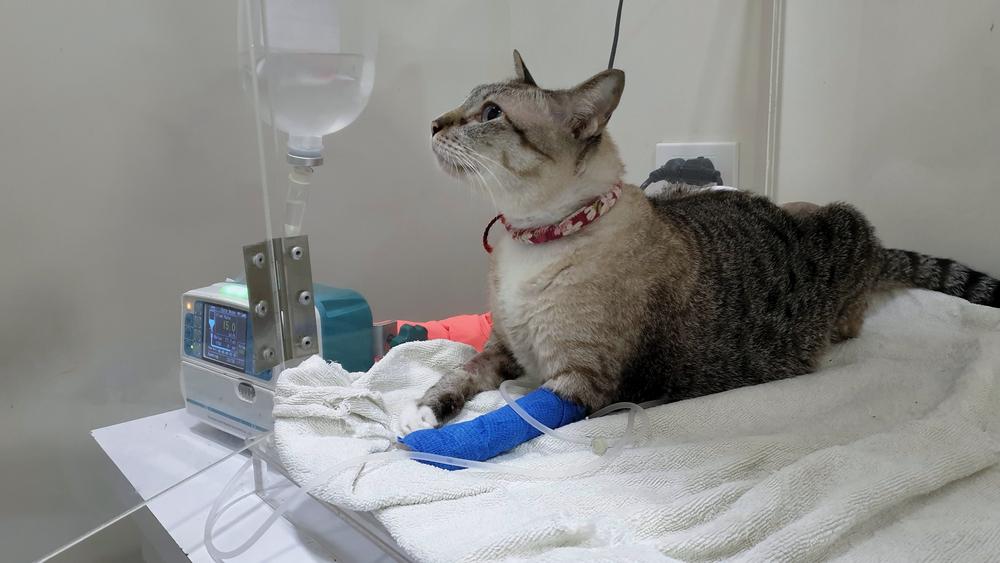
Dehydration is remedied with fluid therapy, either intravenously (IV) or subcutaneously (under the skin).
Dehydrated cats need to be treated by being rehydrated, which means that they have to be given extra fluid. This can be done by oral fluids or by injectable sterile fluids.
Oral fluids may be as simple as water for a mildly dehydrated cat, or an electrolyte-enriched solution in some other cases (e.g., a cat with mild gastroenteritis that has suffered from vomiting or diarrhea).
Injectable sterile fluids are used for fluid therapy to treat a more seriously dehydrated cat. These fluids come in plastic containers, usually in sealed plastic bags, containing 500 milliliters or 1,000 milliliters of fluid. Sometime they come in soft plastic bottles instead.
The bag of fluids has writing on the side that describes what sort of fluids are in the bag. This is like the label on a grocery item, with a description and often a list of ingredients.
The main fluids are known as crystalloid fluids, which means an aqueous solution of mineral salts and other small, water-soluble molecules. The different types include:
- Normal saline: This is the most commonly used intravenous fluid. It is an isotonic crystalloid solution, containing 0.9% sodium chloride, which is the equivalent of blood without any cells or proteins. This contains only electrolytes and fluid. This is used for simple replacement of standard fluid in situations where an animal may be dehydrated with no other issues.
- A balanced electrolyte solution: Known as lactated Ringer’s solution or Hartmann’s’ solution, this contains a combination of electrolytes designed to counter some of the metabolic changes seen in cats that are dehydrated due to issues such as vomiting, certain illnesses, etc.
- Dextrose or glucose is sometimes included in fluids, for situations where a cat may have low blood sugars, as well as dehydration.
- Blood transfusion: Whole blood is sometimes used as a type of fluid therapy in certain critical situations where a cat has lost whole blood in addition to being dehydrated.
How Do Veterinarians Administer Fluid Therapy To Treat Dehydration in Veterinary Hospitals?
First, the amount of fluid needed is calculated by your veterinary professionals, and this is based on a number of different factors:
- The illness or situation
- The presence of hypovolemia as well as dehydration (reduced blood volume, e.g., after an episode of bleeding)
- The degree of dehydration
- Ongoing losses of fluids (e.g., if a cat is bleeding, vomiting or having diarrhea)
- Urine output
The veterinarian calculates two important volumes of fluid. First is the initial bolus of fluid to be given to correct the fluid deficit suffered by the cat. This is a relatively large volume, which is given more quickly.
Second, the volume needed to provide for maintenance fluids based on the normal loss of fluids and need for replacement fluids for a cat.
It’s important to give the correct amount of fluid. If too much fluid is given, as time progresses, there is a serious risk of dangerous fluid overload, where fluid leaks from the bloodstream into the lungs, leading to pulmonary edema, which is a life threatening complication.
Sometimes, injectable fluids may be given subcutaneously instead of intravenously, and this may be done at home by cat carers. The fluids are usually administered between the shoulder blades along the cat’s back, following guidance given by your veterinarian. This is not as effective as intravenous fluid administration, and it is generally reserved for specific cases (such as home treatment of selected cases of chronic renal failure).
How Much Does It Cost To Treat a Cat With Dehydration?
The cost of fluid therapy includes the disposable supplies (needles, intravenous cannula, dressings, plastic tubing, bags of sterile fluids) as well as the use of the equipment (fluid pumps and stands), and the professional time needed to set up and monitor the administration of fluid therapy. When giving subcutaneous fluid therapy at home, the cost of the disposables needs to be covered.
It is impossible to estimate the precise cost, as there are so many possible factors going on in the background of individual cases. You should ask your veterinarian for a detailed estimate before agreeing to proceed with treatment.
However, as a broad indication, fluid therapy in a hospital setting may cost $100 to $200 to set up, with a similar daily amount for maintenance for as long as it is needed. Home sub-cutaneous fluid therapy may cost $50 to $150 for the equipment and training needed.
Conclusion
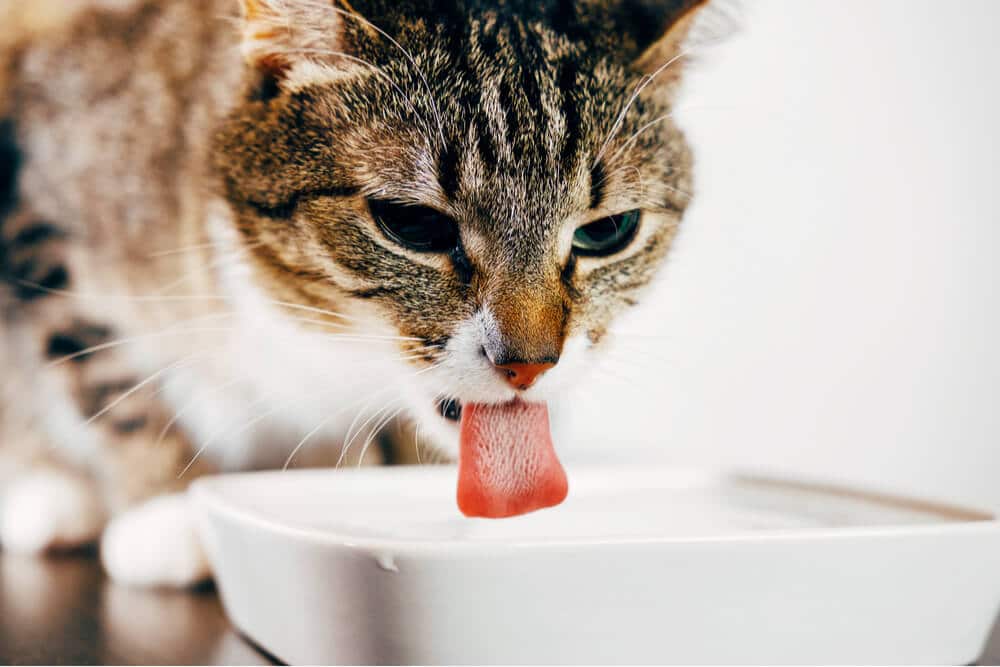
If you notice your cat drinking an abnormally large amount of water, it may be time to bring them to the veterinarian.
Cat dehydration happens when there is excessive fluid loss from the cat’s body without sufficient drinking of water to compensate. This is often associated with underlying serious illnesses provoking the fluid loss, and urgent attention from a veterinarian is usually needed to ensure that the cat is fully and promptly dehydrated.
Frequently Asked Questions
Are subcutaneous fluids enough to treat dehydration in cats?
When a cat is dehydrated, the blood supply to the skin is reduced, so it can take a long time for fluids injected under the skin to reach the circulation. Subcutaneous fluids are better than no fluids, but they are not as effective as intravenous fluids.
Do cats feel unwell when they are dehydrated?
If a cat is dehydrated, they feel miserable, a bit like a human with a hangover. Rehydration, by fluid therapy, often makes cats feel immediately more comfortable, and they will start to respond more, being more awake, active and engaging more with their owners.
How long does it take for a cat to feel better after treatment for dehydration?
A dehydrated cat will feel better as soon as they are rehydrated, which can be just minutes after intravenous fluids have been given, or hours after subcutaneous fluids have been administered.
Can dehydration be prevented in cats?
While dehydration is inevitable in some disease conditions, you can reduce the risk of dehydradtidon by ensuring that your cat has continual access to fresh water in a clean bowl every day. Consider using a wide water dish (to avoid the theoretical risk of whisker fatigue) or a cat water fountain (some cats prefer to drink moving water).
Feeding some wet cat food helps a cat take in more water, as moist food contains around 80% of fluid.
What amount of water does my cat need to drink every day?
Cats need to consume around 60 milliliters per kilogram of body weight (4 ounces of water per 5 pounds of their body weight) daily. An average 4.4 kilogram (10 pound) cat should drink about 260 milliliters (8 ounces or one cup of water) per day.
Cats that eat wet food, which can contain up to 80% water, will drink less than this, while cats that eat dry food usually take more of their daily water requirement in by drinking.
What can I do to make my cat drink more water?
Water intake can be boosted in several ways.
Try adding a small amount of tuna juice or chicken stock to their water bowl.
Instead of dry food, try giving them wet food.
Place some ice cubes in their water bowl.
Clean water bowls daily so that they are clean and odor free.
Provide fresh water in water bowls daily.
Provide water bowls at different locations around your house for the cat to drink water from.
Offer your cat an electrolyte supplement or meat-flavored water designed for cats to drink.
Use a cat water fountain to encourage them to drink. Some cats prefer to drink running water.
Try bottled water. Some cats don't like the taste of faucet water so they may not drink enough.




